Cruising on Seventh Heaven
The last 30 days,
Years
2006,
2007,
2008,
2009,
2010,
2011,
2012,
2013 or
view the entire archive.
|
hello world27 Oct 2008:
Epilogue
Our three months sailing the waters of Indonesia has been an amazing adventure.
We have covered over 2800 miles and visited many islands ranging from the most primitive to the most sophisticated from the driest to the wettest.
We have seen amazing sights such as anchoring under an active volcano, the Komodo Islands, the Borobudur Temple and the Orangutans just to name a few.
We have experienced Indonesian cuisine, culture, art, architecture, and community life.
We have been hosted by local Regents and Government, invited to gala dinners and treated as V.I.P’s.
But most of all the friendliness and hospitality shown towards us by the Indonesian people whether Christian or Muslim has been simply overwhelming and they will remain in our hearts forever.
Photo:
The Indonesian People
|

+ Click to enlarge
|
12 Nov 2008:
Welcome to Singapore
The Republic of Singapore Yacht Club was our first marina berth since leaving Darwin and they do things slightly different up here. The first thing you notice is that there are cheerful marina staff to take your lines then there are the facilities modern clean amenity blocks, pool, gym, library, free internet, TV lounge, bars and cheap restaurants all for $23 per day.
One thing they didn’t have were trolleys instead when you came back from shopping your goods and yourself would be promptly loaded into a electric buggy and then driven to your boat (the fingers are built wide enough to accommodate buggies). The only downside was a lot of movement through the marina caused by the heavy harbour traffic during the day but one managed to survive.
We had twelve yachts from the rally staying at RSYC so marina life was always busy with outings to the cinema, restaurants, Nanette’s birthday (Truest Passion) and Melbourne Cup Day where the marina staff organised a satellite TV coverage for just us yachties. Meanwhile over at Raffles marina where there were about the same number of rally yachts berthed we were invited to a tenpin bowling night (we didn’t have bowling lanes at RSYC) which by the way was won by RSYC and to a very impressive gala dinner hosted by Raffles Yacht Club. Yes still being treated as VIP’s.
Photos:
Jim, Warwick and Charlie Melbourne Cup
Victorious RSYC Bowling Team
|
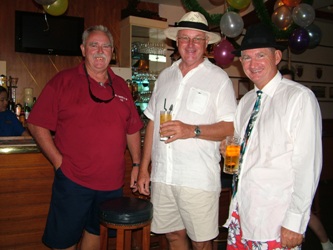
+ Click to enlarge
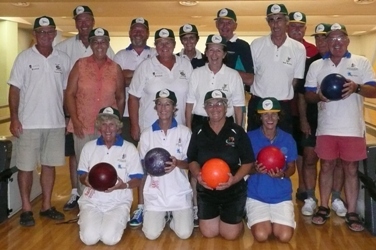
+ Click to enlarge
|
13 Nov 2008:
Singapore
Singapore has been a trading post on and off for centuries and in 1819 Sir Stamford Raffles of the British East Indian Company established Singapore as a British colony. This was the start of modern day Singapore with immigrants coming from all over Asia with the majority Chinese creating a diverse cultural melting pot.
On 15 February 1942 Singapore fell to the Japanese and during their three and half year rule tens of thousands of Singaporean civilians and allied forces were executed or imprisoned. After the war the Peoples Action Party won government and Singapore become independent in 1965.
Singapore today is a modern city which still has that mixture of race, culture and traditions and was fantastic to explore.
There are so many things to do in Singapore we visited Old China Town, Little India, did the Singapore River cruise, went to the night zoo safari, had high tea at the famous Raffles Hotel and spent countless hours just walking around. We also met up with local residents Eric and Sandra who we met on the 2008 Dent to Dunk rally and they chauffeured us around showing us many of the sights of Singapore including the very interesting Labrador Tunnels used by the British army and abandoned during the war and only rediscovered recently.
The one place of special interest to us was the Changi Museum as my father was a POW in Changi. It was a grim reminder of the brutality of war but told an amazing story of heroism and a spirit to survive.
Photos:
Betty and the Merlion
Eric and Sandra at Labrador Tunnels
Raffles Hotel
|
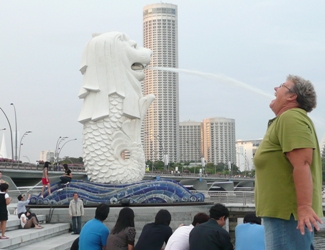
+ Click to enlarge
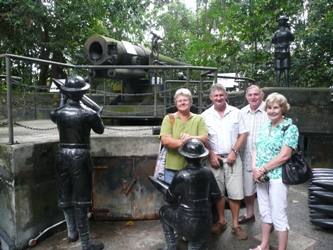
+ Click to enlarge

+ Click to enlarge
|
17 Nov 2008:
Sail Malaysia
After 18 days of R & R in Singapore it was time to head off on the next leg of our journey.
We joined the Sail Malaysia passage to Langkawi rally which traveled up the Straits of Malacca along the west coast of Peninsular Malaysia.
Our first port of call was Johor Bahru the southern most Malaysian city. We anchored at Danga Bay a popular tourist area with lots of cheap restaurants and shops about 5 klm west of Johor Bahru.
As in Indonesia we were treated as VIP’s with a coach tour of Johor Bahru and outlying areas complete with police escort and we were also treated to a wonderful welcome dinner.
Johor Bahru is the gateway to Singapore linked by the causeway (bridge) over the Straits of Johor. Although Malaysia is only 1 klm from Singapore, being a Muslim country the culture and food is totally different.
In the late 19th century Johor was ruled by the Sultan Abu Bakar and he was regarded as the father of modern day Johor. During his rein he built the Istana Besar (Grand Palace) which today is the royal museum and the Sultan Abu Bakar mosque the two landmark buildings of Johor Bahru.
Photos:
Sultan Abu Bakar Mosque
Traditional Dancer
|

+ Click to enlarge
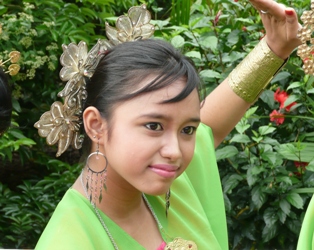
+ Click to enlarge
|
25 Nov 2008:
Port Dickson
We continued day sailing up the Malacca Strait in light conditions to Port Dickson anchoring overnight on the way at Pulau Pisang and Pulau Besar (Pulau is Malay for Island)
Admiral Marina and Leisure club about five kilometers south of Port Dickson was a lovely complex with full facilities such as pool, gym, bar etc. and only a short walk to local cheap restaurants.
We left Seventh Heaven in the marina and with Jim and Cheryl from Odyssey 9 drove down to the historical city of Malaka staying at the Chong Hoe hotel in the centre of old China town.
Melaka has a rich and colourful past. It was first ruled in 1403 by an exiled Hindu prince from Sumatra called Raja Iskandar then in 1511 conquered by the Portuguese and again by the Dutch in 1641 and finally the British in 1824 until independence in 1957. In the 16th century Melaka was the major trading centre in the region.
Melaka was a fantastic city to explore with all its old buildings, museums, churches, temples, night markets and great food.
Photos:
Trishaws
Night markets
Sultanate Palace
|
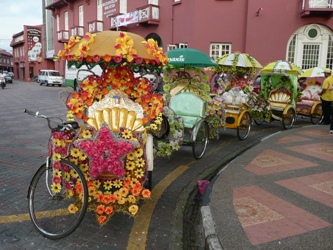
+ Click to enlarge
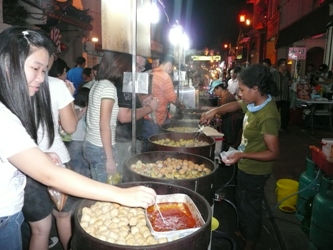
+ Click to enlarge

+ Click to enlarge
|
02 Dec 2008:
Lumut – Pulau Pangkor
We left Admiral Marina at day break and anchored of Kuala Selangor at sunset. As we still had 82nm to travel we up anchored at 2.30am to make sure we would arrive at Lumut in daylight. About one hour before dawn we came across a fleet of about fifty trawlers going every which way with very suspect navigation lights if any which made navigation interesting for a few hours and definitely kept us awake.
Lumut is a quite coastal town with a natural harbour at the mouth of the Dindings River with its entrance protected by Pulau Pangkor and is the main base for the Royal Malaysian Navy.
We anchored in a branch off the main river opposite the yacht club ten minutes walk from the town centre. The town centre is small but busy with many shops and restaurants and is where the ferries depart for Pulau Pangkor a popular tourist destination.
We were again treated to a welcoming dinner hosted by Perak Tourism and a tour of Lumut including an interesting shell museum and turtle management and research centre where we released some baby turtles only to find out later that this is usually carried out at night to give them a better chance of survival. Bugger!!!
Except for Betty loosing her purse and credit cards and me catching a tummy bug our stay in Lumut was very enjoyable
We motored the 10nm from Lumut to Pulau Pangkor passing the fishing villages on the east coast and anchoring at Pasir Bogak on the west coast in a lovely bay with sandy beach. For the first time since Indonesia the water was clean enough to swim and we gave the waterline a good scrub. We hired a motor bike with empty tank of petrol and explored the island which was exhilarating to say the least even though we never got out of second gear. On return the proprietor quickly sent his boy down to drain the excess petrol out of the tank so the next customer would also have an empty tank. Such is life!!!
Photos
Releasing doomed baby turtles
Fishing Village Pulau Pangkor
|
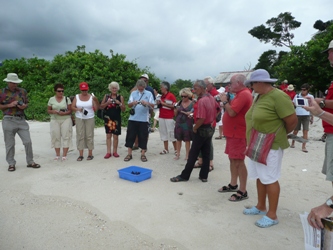
+ Click to enlarge
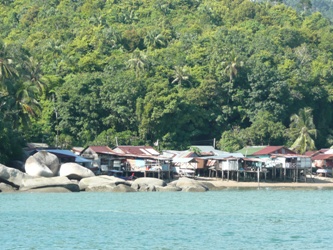
+ Click to enlarge
|
05 Dec 2008:
Penang
On arriving in Penang we anchored off Pulau Jerejak at the south eastern end of Penang where we were given a tour of Pen Marine boat yard and then dinner for eighty guests in the garden of the owner’s house. Amazing!!!
Next day we decorated our boats and sailed north in convoy to Tanjong City marina passing under the Penang bridge which was built in 1985 and connects Penang with the mainland.
The marina was not the most comfortable with lots of wave motion from the ferries and a disco on the adjacent pier but its location right in the heart of Georgetown was fantastic.
Photos
In convoy passing under the bridge
Jemimah all dressed up
|
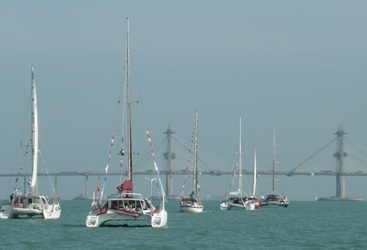
+ Click to enlarge
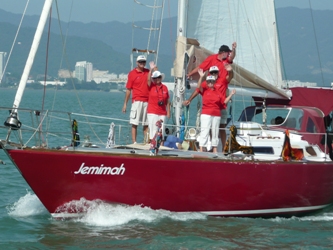
+ Click to enlarge
|
13 Dec 2008:
Georgetown Penang
Penang became a British trading post in 1786 when Captain Francis Light landed at the site of Fort Cornwallis and took possession of the island for the East India Company and for over 100 years it was a major trading centre. During this time settlers came from China, India, Europe and many parts of Southeast Asia which gives Penang a muti ethnic society with a diverse culture, cuisine and architecture.
We spent many days exploring China town with its hundreds of shuttered two story shophouses, markets and temples. Also in the centre of China town is little India with brightly coloured sari shops and smells of incense and curry and loud bollywood music.
The north eastern end of town takes you back to the colonial past with many beautiful buildings constructed during the 19th century including the town hall, court house, St George’s church and the Eastern and Oriental hotel built by the Sarkies brothers who also built Raffles in Singapore.
We had an amazing banquet there one night complete with a trio to serenade us. It was as we had stepped back in time and the cost was 99 ringetts ($A40) per head including beer and wine.
Other nights we would venture out into China town and little India and enjoy great local food.
Photos
Street market – Chicken Lady
Indian food stall
Chinese hardware shop
|
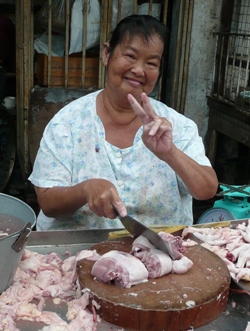
+ Click to enlarge

+ Click to enlarge
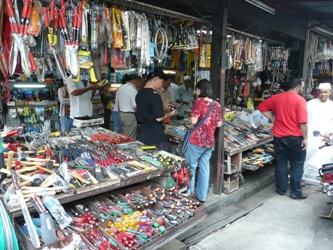
+ Click to enlarge
|
18 Dec 2008:
Langkawi
Leaving the hustle and bustle of Georgetown we sailed north to Langkawi a group of 99 islands (most are only scrub clad rocks) lying 30 klm off the far northern west coast of Peninsular Malaysia and our final destination for the rally.
Although the last month sailing up the west coast of Peninsular Malaysia was a fantastic culture and historic adventure the anchorages were far from idealistic.
Our first anchorage in Langkawi was at the southern end of Pulau Dayang Bunting a beautiful uninhabited small bay with white sandy beach and a backdrop of high limestone cliffs and lush tropical forest. In the early morning and late afternoon macaque monkeys and monitor lizards would comb the shore line in search of food and sea eagles and kites would fly around the cliff tops. We spent the next five days around the south of Pulau Dayang Bunting just relaxing and exploring different anchorages. This was more like the brochure!!!
Also on the island was a large tranquil freshwater lake called ‘Lake of the Pregnant Maiden’ and legend has it that a lovely fairy princess who married an earthly princess had a child that died soon after birth and she buried it in the crystal clear waters of the lake and before she returned to the heavens blessed the waters so that any childless maiden who bathed in the lake would conceive thereafter. You can imagine that I was a little concerned when Betty went for a swim.
Photos
Our first anchorage – Pulau Dayang Bunting
Lake of the Pregnant Maiden
|

+ Click to enlarge
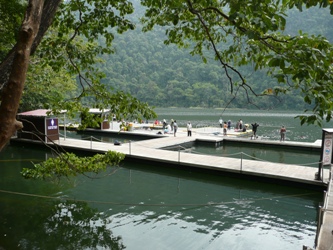
+ Click to enlarge
|
23 Dec 2008:
The Rally Ends
Telaga Harbour Marina was the venue for the final rally events. We anchored off inside two man made islands which were built to protect the marina entrance.
The official welcoming was held at Makam Mahsuri the site of Langkawi’s most famous legend. Here a memorial is erected in the honour of Mahsuri a fair maiden born over 200 years ago who was unjustly accused of adultery and sentenced to death. She was tied to a stake and as the ceremonial dagger was plunged into her body she bled white blood a sign that proved her innocence. In her dying breath she laid a curse on the islands prosperity to last seven generations. Fact or friction seven generations has passed and today Langkawi is flourishing.
At the welcoming we were treated to a tasty super and performances of local music and dance and afterwards walked around the grounds and visited the museum.
The farewell dinner was held at Mutiara Burau Bay resort on the water front and was a grand event with a delicious smorgasbord dinner and live band. It was also a time for goodbyes as this was the point where we would go our own ways. Some would be flying home for the Christmas holidays others are continuing on to Thailand and beyond and many like us staying in Langkawi.
For us the rallies have been amazing so many new places visited and new friends made.
Photos
The official welcome
Gabby (Pampero) and Mary (Investigator) at farewell dinner
Stuart & Nanette (Truest Passion) and Richard & Susan (Sea Bunny) at farewell dinner
|

+ Click to enlarge

+ Click to enlarge

+ Click to enlarge
|
24 Dec 2008:
Christmas and New Year in Langkawi
Along with about 20 other boats from the rally we decided to spend Christmas and New Year in Rebak Resort Marina.
Rebak is a small island just off the southwestern end of the main island of Langkawi. The marina is a man made lagoon within the island protected from all weather and is integrated with a luxury resort. As marina guests you may use all the resort facilities and there is a budget BYO restaurant called ‘The Hard Dock Café’ which is just for yachties. Cost per night $16 Australian. I here you say “stuck on an island resort” not so there is a regular free speed boat service to Langkawi where you can hire a car ($15 per day) and explore or shop or walk from the jetty to a number of local cheap restaurants.
Absolutely fantastic.
Photo
Rebak Marina
|
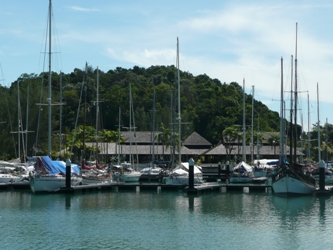
+ Click to enlarge
|
25 Dec 2008:
The night before Christmas
There was a buzz around the marina people decorating their boats the staff practicing Christmas carols and Mazrizal the young marina manager visiting every boat with a gift of biscuits and cakes. We were eagerly waiting for the mail to arrive as you may recall Betty lost her credit cards in Lumut and as they were in joint accounts we had to cancel both and we had been living on a tight budget for the last month. True to form Santa delivered our new cards which were a very welcomed Christmas present.
Christmas Day
The day started with pre lunch drinks on the dock with Pattie off ‘This Way Up’ serving pims and lemonade and everybody showing off their Christmas head wear.
This was followed by a four hour banquet at the poolside restaurant for about sixty yachties. During lunch we were entertained by the staff choir with a Malay version of Christmas carols.
After an afternoon nap it was over to ‘Investigator II’ (the mother ship) for evening drinks and nibbles and even though it rained more than twenty people managed to squeeze in the cockpit under the covers.
A very memorable day considering we are in a Muslim country where they do not celebrate Christmas.
Photos
Drinks on the dock –Mary and Alan off ‘Investigator II’
Rebak Staff Choir
|

+ Click to enlarge
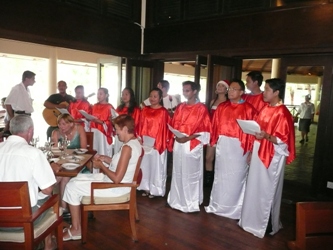
+ Click to enlarge
|
01 Jan 2009:
The New Year.
Between Christmas and New Year we just relaxed and got to know the other yachties in the marina many were from past rallies that were still here enjoying this part of the world. We provisioned with all the luxury items cheese, dried tomatoes, olives, meat etc. and stocked up on duty free grog.
One evening we had a kalie (Scottish sing a long) where the yachties from all over the world either sang, played a musical instrument or recited poetry our contribution was a rendition of ‘Aussie Jingle Bells’ backed by some talented musicians.
New Years Eve
The venue for our New Years Eve bash was the Hard Dock Café at Rebak marina where one hundred yachties enjoyed a Thai smorgasbord and danced to music from our very talented DJ until the early hours.
Photos
Gill (Destiny III) and Betty
Trevor & Joan (Beenalong) dancing the night away
|
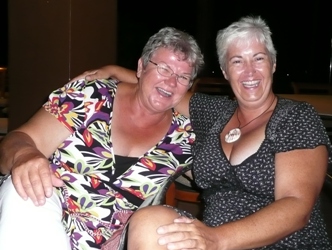
+ Click to enlarge

+ Click to enlarge
|
08 Jan 2009:
Thailand here we come.
We left Rebak marina on New Years Day heading for the tourist island of Phuket in Thailand anchoring along the way at Ko Lipe a small layback resort island, Ko Rok and Phi Phi Don. We anchored in Ao Chalong a large protected bay on the southeast end of Phuket where customs and immigration are located. This is where most yachts check in and out of east Thailand and provision so there is always many yachts anchored off. It is also a very busy tourist port where charter boats of all descriptions embark on day trips to the outer islands and Phang Nga Bay.
Our first visitor had arrived to stay with us. This was Johnny’s first stop on a 60 day round the world adventure. (See Dot Com Cruising left hand menu).
We sailed out to Phi Phi Le famous as the setting for the movie ‘The Beach’ and arrived just as the day trippers were leaving. Anchored in Maya Bay surrounded by soaring limestone cliffs and sparkling water we went for a snorkel then watched the sunset over a beer. Johnny is in seventh heaven.
Next morning it was over to Phi Phi Don the most popular tourist island in the region. The island was badly damaged in the 2004 tsunami and many lives were lost but after undergoing a massive rebuilding program Phi Phi Don is quickly returning to its pre tsunami days. The anchorage in Ton Sai Bay is protected buy huge limestone cliffs with fringing coral reef and clear water but unfortunately it is also full of tourist boats. There are resorts spread around the foreshore and the village is a hub of activity with its narrow streets full of vendors, souvenir shops, dive shops, restaurants and backpacker bungalows.
Our next anchorage was Ko Racha Yai in a beautiful bay with crystal clear water fringing coral reef and fine white sandy beach. At the head of the bay was a local restaurant on the rocks and a five star boutique resort. I don’t think Johnny wants to leave.
Photos
Longtail Maya Bay Phi Phi Le
Ton Sai Bay Phi Phi Don
Johnny and Betty – Restaurant on the rocks Ko Racha Yai.
P.S.
We hired a Sunsail yacht out of Phuket with our friends Bob and Lesley in March 2003 and it was pleasing to see that the area has recovered from the devastating tsunami of 2004. The tourist are returning, Phi Phi Don has been rebuilt and is much cleaner and has a better infrastructure in place and our favorite little restaurant on the rocks at Ko Racha Yai has survived.
|

+ Click to enlarge
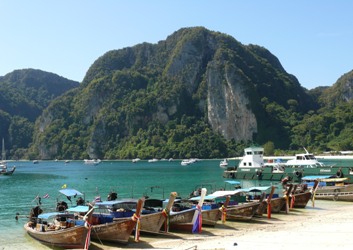
+ Click to enlarge
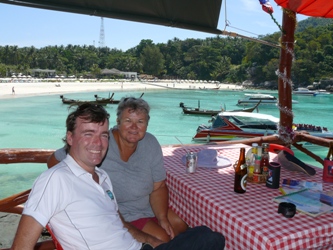
+ Click to enlarge
|
25 Jan 2009:
Our visit up to Phuket was very short mostly taken up with Johnny’s visit and a wonderful six days R & R at Luguna Holiday Club Resort on Bang Tao Beach with Dave and Pattie off ‘This Way Up’.
We anchored our boats off the beach in front of the resort and just spent the time lazing around the pool, walking along the beach and enjoying lovely sunset dinners at the local alfresco restaurants on the beach. A nice change after being on ‘Seventh Heaven’ for the last nine months.
Photos:
Alfresco dinning on Bang Tao Beach with Pattie, Dave and Johnny.
Luguna Holiday Club Resort
|
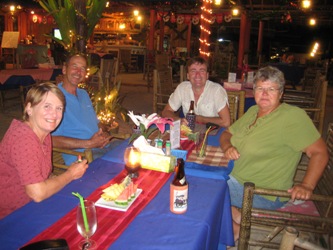
+ Click to enlarge
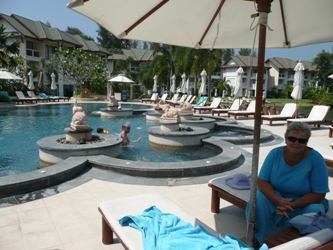
+ Click to enlarge
|
02 Feb 2009:
Visit Home
Charlie and I returned to Australia early February as we were going to be grandparents. Kathryn and Ken were due to have a baby girl (well Kath was).
We were met by Ken and Kath at 8am, blurry-eyed and tired at the Gold Coast airport after having traveled for sixteen hours by ferry boat, taxi, and plane from Rebak Island Langkawi to Gold Coast.
Straight away it was off to breakfast – real bacon and eggs, real bread, real cappuccinos – expensive after the cheapness of Asia, but after the last eight months of living without these, it was truly wonderful.
Though we spent most of our time on the Gold Coast we did get to Mackay in a whirlwind trip to attend Greg Tobin’s 50th birthday party. It was like a grand reunion of the crew that did the Sydney to Hobart on 'Dehler Magic' and the old 'Taminda' days. A very big night was had by all, though Greg and Sandy (Greg’s wife) really did not appreciate Charlie sleeping with them. We also made time to get our taxes done and visit our financial planner (not that he could give us any startling news or ideas).
Emma came down from Townsville to escape the wet and to celebrate her 27th Birthday with us on the Gold Coast. We had home cooked lamb roast with all the trimmings and Baskin Robin ice-cream cake.
Photos:
Greg's 50th The 'Taminda' Boys
Emma's 27th
|

+ Click to enlarge

+ Click to enlarge
|
19 Feb 2009:
19th February 2009
Mia’s Birthday
We all rose at 4.30am and had coffee as Kathryn couldn’t sleep, her admission for an induction was for 6.30am. As the day progressed Kathryn’s labour was not going quite to plan so after sixteen hours it was off to surgery for a caesarean. All went very well and Mia was born at 10.50 pm (2250 for us yachties) weighed in at 9lb 8oz (4.32kg) and was 20.3” (51.5cm) long.
Within half an hour of Mia being born we were able to play Granny and Granddad what a special moment.
Photos:
A little miracle
Granny and Mia
Mia’s web site www.miaogilvie.com
|

+ Click to enlarge

+ Click to enlarge

+ Click to enlarge
|
31 Mar 2009:
Our stay on the Gold Coast was longer than anticipated due to Kathryn’s recovery time but it gave us lots of time with Mia. During this time we visited my sister Rose at Nanago and I spent a few days with Emma in Brisbane who had returned from Townsville with glandular fever meanwhile Charlie kept himself occupied unit hunting (we decided to purchase a unit on the Gold Coast as we will be spending more time there in the future). We found a nice two bedroom holiday unit at Burleigh Heads 100 meters from the beach with unlimited owners use plus we could leave the car there while we were away. We have already booked the unit for Christmas and New Year.
We managed to get up to Airlie for the last week of our visit home and spent some time with friends sharing our adventures.
Photos:
More Mia Time
Our new Gold Coast unit
|
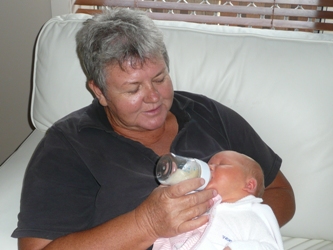
+ Click to enlarge
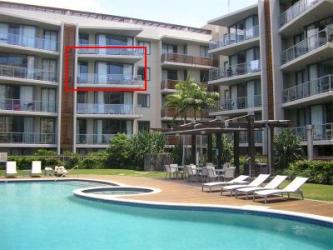
+ Click to enlarge
|
26 Jun 2009:
Phuket Revisited
After retuning from our visit home we cruised from Langkawi to Phuket in company with Warwick and Maryon on ‘Nimbus II’ exploring the various island anchorages along the way including Koh Muk which has an amazing cathedral like hong 60m in diameter known as the Emerald Cave accessed by dinghy through a 80m long dark cave.
A hong (Thai for room) is like a hole in the island open to the sky accessible by a cave.
Arriving in Phuket we spent the first two weeks in Boat Lagoon Marina having our radar and genset repaired. The genset had a burnt out exhaust valve. The head and block were removed then the head was machined and new valve fitted the cylinder honed and reassembled for a total price of $320 Aust.
We also took advantage of this time to explore Phuket Island which is only 50 klm long and 25 klm wide and has a population of 85000 people. We visited the tourist destinations along the west coast with white sandy beaches crammed with hotels and condominiums, bars, restaurants and souvenir shops. To the east lies Old Phuket Town with its narrow streets full of old shuttered two storey specialty shop houses, interesting people and cheap and cheerful Thai restaurants serving excellent food which is in contrast to the centre of the island where you will find modern shopping malls, supermarkets and home improvement centres similar to Australia.
Leaving the marina we had a month cruising the emerald green waters of picturesque Phang Nga Bay that has a landscape like no other. The scenery is spectacular with rugged rainforest covered limestone islands concealing many hongs, caves and creeks to explore. Most of the islands are uninhabited except for a few small fishing villages whose fishermen always have fresh prawns to trade.
Photos
Inside the Emerald Cave Koh Muk (entrance behind dinghy)
Anchored at Phi Phi Lei
Limestone overhangs Phang Nga Bay
|

+ Click to enlarge
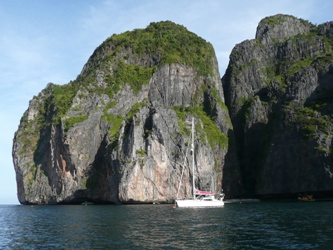
+ Click to enlarge
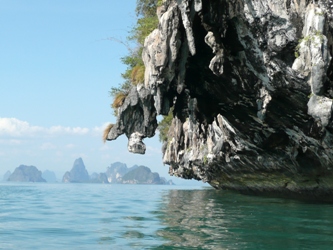
+ Click to enlarge
|
27 Jun 2009:
Emma’s Visit.
In June we had the pleasure of a visit from our daughter Emma.
We had a berth at Ao Po Grand Marina so Emma could have a good nights rest in air conditioning after her flight from Australia. In hindsight this was a wise decision as we had strong winds and continuous rain the next two days then the weather cleared giving us ten days of perfect conditions.
We sailed up to Phang Nga Bay exploring the caves and hongs of Koh Phanak and Koh Hong then up to Koh Pan Yai to the Muslim fishing village on stilts. Here we hired a longtail ( Narrow wooden boat about 10m long with long propeller shaft extending from large pivoting engine mounted on the stern ) and traveled along the many mangrove lined waterways which harbour many marine species, reptiles, birds and monkeys. We passed through natural limestone arches full of stalactites and saw cave paintings that are said to be 3000 years old that were similar to aboriginal cave paintings. On our way to nearby Koh Phing Kan (James Bond Island) we were hit by a squall which tipped the longtail on its side. With the crew (that would be us) quickly moving to the high side the boat eventually came upright and our skipper wasting no time headed straight for a small beach. After the squall had past and our nerves had settled we left the sanctuary of our little beach and continued on to James Bond Island where the 1974 movie ‘The Man with a Golden Gun’ was filmed. This once idyllic little island is now a major tourist attraction with boats coming and going all day and the beach full of souvenir vendors. We finished the day off with a late lunch of BBQ and deep fried chilli fish selected from their farm at one of the excellent seafood restaurants at the Muslim fishing village.
Photos:
Emma and Betty at James Bond Island.
Muslim fishing village.
Our longtail passing through limestone arch.
|
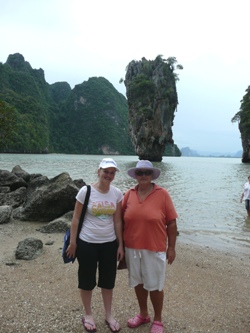
+ Click to enlarge
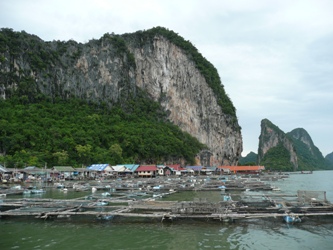
+ Click to enlarge
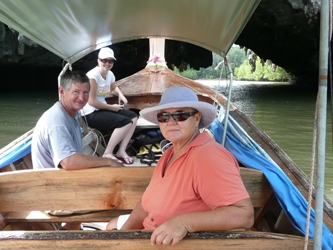
+ Click to enlarge
|
28 Jun 2009:
The next two nights we slowed down the pace anchoring on the east side of Koh Yao Noi with a day sail to Koh Pak Bia and Koh Hong (Krabi) were we enjoyed some snorkeling.
We had a lovely sail down to Koh Phi Phi Don where again we hired a longtail to explore the crystal clear waters and white sandy beaches of Koh Phi Phi Le.
Our final destination was Ao Chalong at the south eastern end of Phuket were we hired a car a did the tourist dive around the island, checked out the night life at Patong the bars, go go girls and much more, sampled the best of Thai food and went to Phuket Fantasea a Thai theme park with a theater that holds 4000 people. This production was world class and this magical show captured the colour and pageantry of traditional Thai dance and costumes combined with a magnificent light and sound show and at times there were up to twenty elephants performing on stage.
Exhausted and bubbling from her Thai experience it was time for Emma to return to Australia and for us to head back to Langkawi to start our next adventure.
Photos:
Emma and us at The Natural restaurant Old Phuket Town
Emma playing with the elephants
|
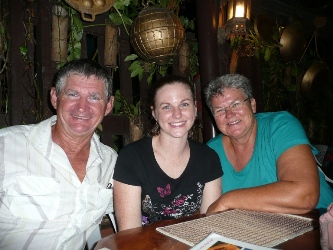
+ Click to enlarge
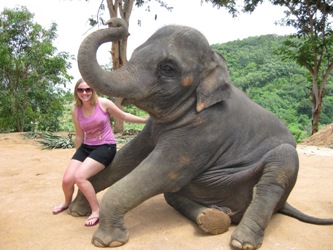
+ Click to enlarge
|
05 Jul 2009:
Northern Thailand
Chiang Mai
Together with Warwick and Maryon we boarded our Air Asia flight bound for Chiang Mai.
Chiang Mai is located in a beautiful valley surrounded mystical mountains and although the second largest city in Thailand only has a population of just over 200000.
Chiang Mai is a unique blend of old and new. The quaint old moated and walled city with its markets, traditional shop houses and Wats (Buddhist temples) is in contrast surrounded by high rise office buildings, modern hotels and shopping complexes.
We stayed at the Parosol Inn in the heart of the old city from here we roamed around the streets taking in the sights, enjoying the night markets and local food.
Chiang Mai with more than 300 Wats dating back as far as 1296 is definitely the city of temples. We visited many of these Wats all architecturally slightly different depending on the period of construction with elaborate murals on the walls depicting popular Thai stories and religious events not to mention the amazing Buddha images.
The most sacred of these temples is Wat Phra That Doi Suthep built in 1383 on top of a mountain overlooking the city. At the end of the road up the mountain a staircase of 306 steps leads up to the Wat and 79 feet high Golden Chedi (conical Buddhist monument used to inter sacred objects).
Chiang Mai is also renowned for its arts and crafts, woodcarving, lacquer ware, rattan, silverwork and bronze castings.
We visited a Thai silk factory where we were shown the process from silk worm to extraordinary garments and an umbrella village where they make hand painted paper umbrellas using pulped mulberry tree bark to produce the paper and the wood for the frames that are exported world wide.
Photos
Buddha Statues - Wat Phra That Doi Suthep
Golden Chedi - Wat Phra That Doi Suthep
Paper Umbrella Making
|
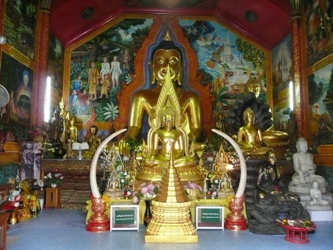
+ Click to enlarge
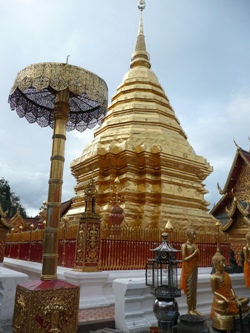
+ Click to enlarge

+ Click to enlarge
|
06 Jul 2009:
Day Tripping
From Chiang Mai we did a day trip up to Tha Ton on the border of Thailand and Myanmar (Burma) high in the mountains to visit some of the hill tribes that live in this area.
The hill tribe people are ethnic minorities that have come from Tibet, Myanmar, China and Laos during the past 200 years. They have crossed borders into Thailand fleeing oppression and are basically refugees lacking Thai citizenship. They live in small villages on the mountain sloops in houses built of wood and bamboo with thatched grass roofs growing rice, corn and opium and making handicrafts.
There are ten known hill tribes with an estimated population of 550000 which have their individual language, customs and spiritual beliefs. We visited the village of an Akha tribe and a Karen tribe.
The Akha tribe originated from Tibet and the women can be easily identified by their colourful headdress of beads, feathers and dangling silver ornaments also their teeth are usually black from chewing beetle nut.
The Karen longneck tribe originated from Myanmar and the women wear a continuous coil made of solid brass around their neck which rarely comes off. These coils are fitted to girls at about age six and consist of four of five coils being added to each year until adulthood when the coil weighs approx 5kg and has twenty six coils.
The coils depress the collarbone and ribcage which makes their neck look elongated. The origin of the coils is unsure some say it was to make women unattractive to men from other tribes or to protect their throats from tiger attacks.
I must admit that when we first arrived at the village we felt as though these women were being exploited but after spending some time with these softly spoken gentle people and learning about their lives you came to accept their customs.
Photos
Akha Woman
Karen Longneck Woman
Karen Longneck Girl with Betty
|
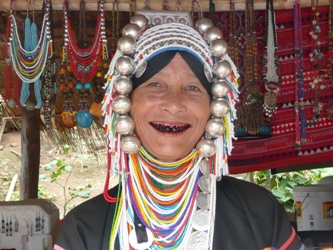
+ Click to enlarge
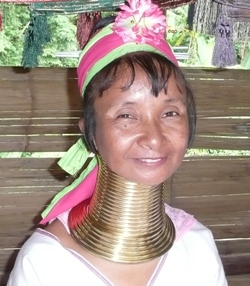
+ Click to enlarge
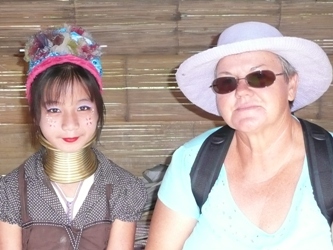
+ Click to enlarge
|
07 Jul 2009:
Chiang Rai
Chiang Rai is 180 klm north of Chiang Mai a 3½ hour scenic bus trip through mountain ranges and fertile rural flood plains of the Mekong River.
Chiang Rai though much smaller than Chiang Mai still had many interesting sights. In the past Chiang Rai was the centre of the opium trade in Thailand commonly known as the ‘Golden Triangle’ but today due to tougher law enforcement this trade has all but ceased.
We traveled north to Doi Tung (Doi means mountain) where at the summit (1420 m) is Wat Phra That Doi Tung and two golden Chedi built in 911 great views or so they say as unfortunately on the day of our visit the summit was cloud covered. On the slopes of Doi Tung is the Royal Villa built by the late Princess Mother (the Kings mother). The Princess Mother spent many years living in Switzerland where her children were educated and the villa is built from local timber in the architectural style of a Swiss chalet. It is now open to the public as a museum. Adjacent to the Royal Villa is the Mae Fah Luang Gardens which even on a cloudy and rainy day were spectacular.
Photos
Mae Fah Luang Gardens
Keeping dry on a rainy day
|

+ Click to enlarge
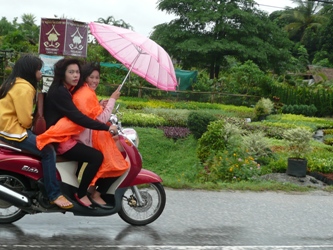
+ Click to enlarge
|
08 Jul 2009:
South of Chaing Rai we visited the unusual Wat Rong Khun. Known as the ‘White Wat’ construction began in 1997 and is still continuing. The exterior is painted completely white and is decorated with millions of small mirror chips. Beneath the entrance bridge to the Wat is a sculpture of reaching arms symbolising a desire to enter the sanctity of the Wat. Inside the murals on the walls depict contemporary themes such as jet planes crashing into the twin towers and space ships exploding quite bizarre.
The night markets had an interesting local food hall with all sorts of exoctic dishes. Warwick and I sampled some old time favorites roast pig intestines which were rather tasty and deep fried crickets, silk worms and bamboo worms which supposedly high in protein tasted like crunchy french fries.
Photos
Wat Rong Khun
Sculpture of Reaching Arms
A tasty feast of crickets and worms
|
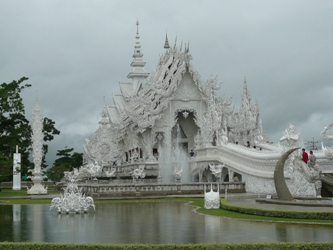
+ Click to enlarge

+ Click to enlarge
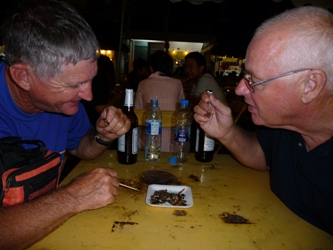
+ Click to enlarge
|
09 Jul 2009:
Chiang Saen
We boarded a local bus for the 1½ hour trip north to Chiang Saen traveling through the fertile rice producing flood plains of the Mekong River.
Chiang Saen is a small boarder town located on the west bank of the Mekong River and in the 14th century was an important Thai kingdom. Within the walled city there are many ruins of wats and chedi that have survived.
Today it is a busy port for river barges importing goods from China and a border crossing for Thai and Lao nationals.
Our hotel was inside the old walled city from where we strolled around the ruins and checked out the delicacies at the local market.
We caught a sawngthaew (small open mini bus) to Sop Ruak 10 km north where the Nam Ruak River and Mekong River converge creating the boarders between Myanmar, Thailand and Laos and is the tourist centre of the Golden Triangle. Here we visited the House of Opium museum displaying the history and culture of opium.
Photos:
Sop Ruak – Golden Triangle
BBQ catfish for lunch
Wat Chedi Luang built 1291 AD
|
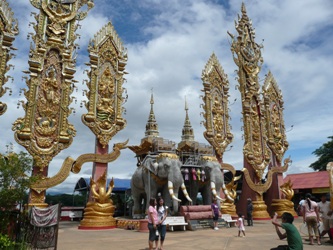
+ Click to enlarge

+ Click to enlarge
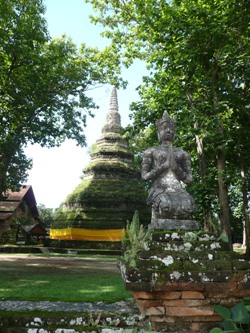
+ Click to enlarge
|
10 Jul 2009:
Chiang Khong
We hired a sawngthaew for the 52 km trip over the mountains to Chiang Khong.
Apart from nearly being asphyxiated by the dust and diesel fumes I am sure our driver had aspirations to be a rally driver.
Chiang Khong a small border town on the Mekong River is the legal border crossing from Thailand to Laos and a market town for local hill tribes and trade from northern Laos.
We stayed in a comfortable and friendly traditional Thai guesthouse (more like a tree house) complete with chooks, cats and dogs overlooking the river.
Next morning we boarded a small river boat and crossed the river into Laos.
Photos
Our Guesthouse on the banks of the Mekong River
Crossing the river to Laos
|

+ Click to enlarge

+ Click to enlarge
|
11 Jul 2009:
Laos
Laos is a small landlocked country with a population of 5.6 million bordered by China, Myanmar (Burma), Thailand, Cambodia and Vietnam.
Laos was a French colony from 1893 to 1953 when it was granted independence and much of the French influence remains. In 1975 after the fall of South Vietnam the communist Lao People’s Democratic Republic Party was formed which saw the end of the 650 year old monarchy and the royal family imprisoned to work in the fields.
Although Laos is a communist country people can farm their own land and private enterprise is permitted mainly to encourage foreign investment.
Huay Xai
Our trip across the Mekong River to Huay Xai took about five minutes. Immigration and customs were located at the boat landing which issued visas on arrival for US$20.
Huay Xai is another small bustling river trading port with Thailand and China. The town centre above the boat landing extends for only a few hundred meters consisting of mainly guest houses.
After checking in to our guest house we strolled down the main street where we found that the most popular commodity was snake wine. Now I don’t mind a drink but there are some limits so unfortunately I cannot tell you what it tastes like.
Photos
Snake Wine and Whisky
Huay Xai
|
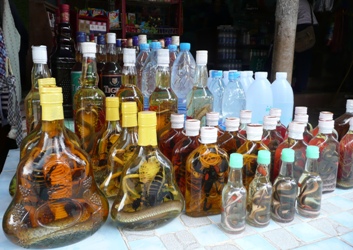
+ Click to enlarge
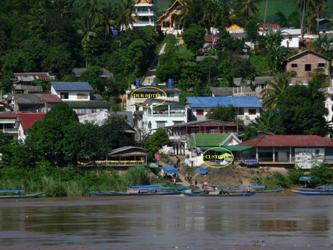
+ Click to enlarge
|
12 Jul 2009:
Down the Mighty Mekong
The Mekong River is 4180 kilometers long and is the 10th longest river in the world. Its source is high in the Tibetan plateau and it flows south through China, Myanmar, Thailand, Laos, Cambodia and Vietnam empting into the South China Sea.
The Mekong River flows 1865 kilometers through Laos and is the natural boundary for most of the country to the west and the artery of life for those who live along its banks.
At Huay Xai we boarded a 34 meter Mekong river boat for a two day 160 kilometer cruise down river to Luang Prabang this was a package that included all meals and two nights accommodation and cost 147 euros per person. Our boat was up market and well appointed with lounge chair seating, bar and galley with only 20 passengers and 8 crew including guide and chef. The local boats carry in excess of 100 passengers seated on wooden bench seats.You can also travel by speed boat but the fatality rate is high.
Photos:
Our Mekong river boat
Charlie and Warwick relaxing down the river
Mekong river speed boat fare includes helmet
|
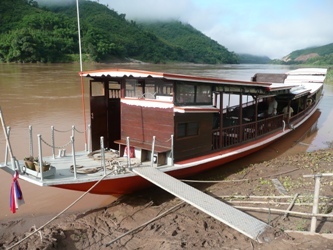
+ Click to enlarge
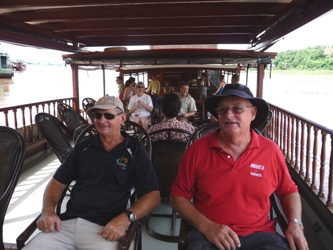
+ Click to enlarge

+ Click to enlarge
|
13 Jul 2009:
The Mekong River between Huay Xai and Luang Prabang is only about 500 meters wide and runs at around 5 knots and with many rocky outcrops swirling eddies and over falls made the trip quite exciting.
The river winds its way through jungle covered mountains, teak plantations and hillside farmland with villages dotted along its banks.
We visited two villages along the way and experienced their day to day life planting rice, tending water buffalo used for ploughing, preparing meals and distilling rice whisky. They must wonder why we find their way of life so interesting as they know nothing of ours.
Along the banks were people fishing in small canoes others panning for gold and elephants extracting timber from the forest.
The river can only be navigated during daylight hours and our overnight destination was Pakbeng a small river town consisting mainly of guest houses and eateries catering for the large number of river travelers. We stayed at the Luang Say Lodge built in traditional Laotian style of solid timber over looking the river and backed by rain forest. From the veranda of our modern bungalow we could watch the river go by and listen to the sounds of the forest.
Next day further down river we explored the Tham Ting (caves of a thousand Buddha’s) which is dedicated to the sprits of the river and is a Buddhist temple.
Arriving in Luang Prabang late afternoon we made our way to the Villa Maly for a quite drink and swim in the pool.
What a glorious two days and totally recommended.
Photos:
Village children
Buddhist Monk
River children improvising
Footnote
Eco friendly Betty with her trusty can of mortein that she never leaves home without managed to kill off half the insect population at our lodge at Pakbeng.
|

+ Click to enlarge
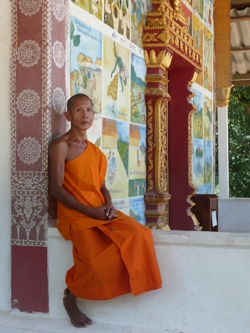
+ Click to enlarge
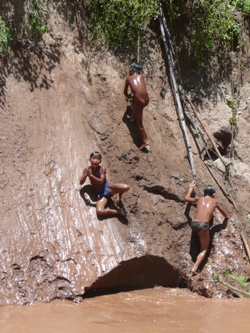
+ Click to enlarge
|
14 Jul 2009:
Luang Prabang lies at the confluence of the Mekong and Nam Khan Rivers and is surrounded by majestically mountain ranges.
Once the Royal capital of Laos it has many ancient and beautiful Buddhist temples throughout the town where each morning hundreds of monks from the various monasteries walk through the streets collecting alms. Along with the magnificent wats a part of the old town's appeal are the many French provincial style houses of which many have been converted into hotels.
The town was great to explore on foot with its narrow street and lanes revealing many handicraft shops, galleries and good restaurants. One of the major landmarks in the town is Mount Phousi. Here you can climb the 328 steps up to Wat Chom Si where there are splendid views of the area.
The Royal Palace is now an excellent museum and also in the grounds is the Royal theatre where we enjoyed a local performance. The story line given to us in an English program made it easy to follow.
At night the town comes to life the main street is cut off to traffic and the night markets are set up stretching for a kilometre selling all sorts of handicrafts, textiles and clothing. The night food stalls have cheap and tasty tucker such as noodle soup, BBQ chicken and fish, salads and fresh fruit. For the more adventurous there was treats such as BBQ intestines, private parts, little baby birds and others unknowns.
Nowadays we rarely party on and are usually early to bed just as well as the town has a 11.30pm curfew and lights out by midnight.
Photos:
Hmong Handicraft Shop.
Theatre Performers.
Warwick enjoyig some street food.
|

+ Click to enlarge
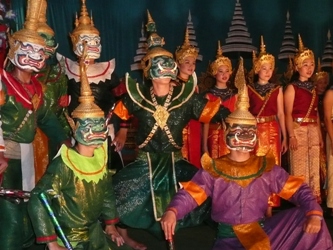
+ Click to enlarge

+ Click to enlarge
|
15 Jul 2009:
Laos was once known as ‘The Land of a Million Elephants’ but today they are an endangered species with only about 1600 remaining.
The elephant village and sanctuary on the Nam Khan River near Luang Prabang rescues working and logging elephants from their harsh and abusive environments giving them a new home and brighter future.
These gentle giants are the largest land animals and live for 60 years weigh 3 to 5 tons and are 2 to 3 meters high and eat a massive 200 kg of food per day.
During our two days at the village we spent many hours with the elephants and their handlers (mahouts) learning about them.
On the first day we were shown how to mount and ride the elephants both in a Howdah (saddle) and on their necks and were taught the basic commands though I don’t think the elephants understood our accent.
During the afternoon we rode the elephants up into the forest where they spent the night roaming for food. We then trekked back to the village and went for a short boat trip up river to the beautiful Tad Sae falls with its many pools to cool off and relax a wonderful way to end the day. That evening we stayed at their lodge and had dinner at the restaurant overlooking the river to the mountains complete with a beautiful rainbow.
Early morning we trekked back up into the forest and rode the elephants down to the river for a swim. We gave them a good scrubbing with a stiff brush which they seemed to enjoy immensely. After our fun in the river we rode back to the village where the elephants were prepared for the next group of tourist to enjoy these wonderous animals.
After saying goodbye to the elephants we kayaked down the Nam Khan River back to Liang Prabang passing through natural forest areas and farmland. The river was flowing at about two knots making paddling easy and negotiating the small rapids was exhilarating.
Photos
View from the Lodge
Time for a good scrub
Betty going for a ride
|

+ Click to enlarge
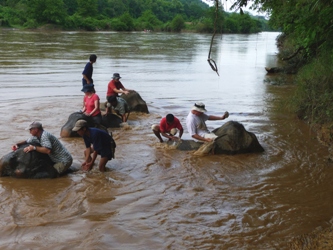
+ Click to enlarge

+ Click to enlarge
|
16 Jul 2009:
From Luang Prabang we hired a mini van with driver and guide and made way to Phonsavan to visit the Plain of Jars. The 8 hour 270 kilometer trip wound its way through rugged mountain ranges with breathtaking scenery and sometimes breathtaking hillside roads.
On the way we stopped to explore the Tham Pha Caves where several hundred local people took refuge during the Indochina war. Still remaining in the network of caverns are remnants of the hospital and a large Buddha sits just inside the main entrance.
Photo:
The road to Phonsavan
|
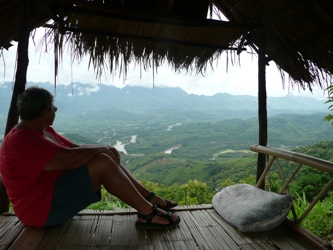
+ Click to enlarge
|
17 Jul 2009:
Phonsavan is the capital of the Xieng Khuang province located on a mountainous plateau in the north east of Laos.
This province was devastated during the Indochina war between 1964 and 1973 during which time the original capital Xieng Khuang was almost totally destroyed by heavy bombing.
More than 2 million tones of ordnance were dropped on Laos giving it the distinction of the most heavily bombed nation in the world.
This conflict has left a deadly legacy that will remain for generations as approximately 30% of these ordnances did not explode and are still lethal. Unexploded ordnances (UXO’s) litter the country side causing land deprivation, accidental injuries and death. The Lao National UXO Programme is working hard to educate people and clear these UXO’s but this will take many more years.
The Plain of Jars extending around Phonsavan is dotted with large carved stone jars weighing between 600 and 6000kg and said to be 2500 years old. The origin of these jars is unknown though some archeologists believe they are funeral urns. Unfortunately archeological digs at these sites are too dangerous due to UXO’s.
Even though Phonsavan is off the beaten track there is plenty to see. The UXO visitor centre run by the Mines Advisory Group (MAG) showed quite graphically the damage resulting from war and how they were helping people rebuild their lives. At the Mulberry silk farm we learnt how they dye silk using local plants and the produce market had lots of interesting delicacies such as rat, guinea pig and mole type creatures. For us our staple diet was noodle soup with who knows what the ingredients were but tasty just the same.
Photos:
Left over ordnance
One of the larger Jars
Plain of Jars note bomb crater in centre of photo.
|
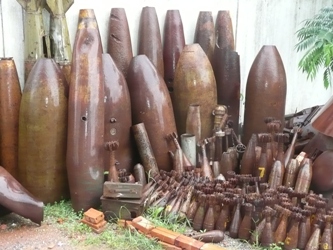
+ Click to enlarge
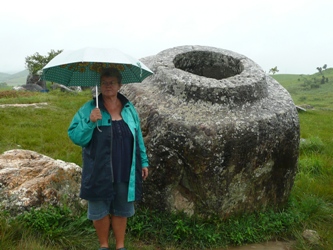
+ Click to enlarge

+ Click to enlarge
|
19 Jul 2009:
We continued our trip through the mountains down to Vientiane on the Mekong River the capitol of Laos. Vientiane is more like a large country town than a city with not a great deal of traffic and wide streets.
The days were very hot so we only visited a few of the sights.
Pha Lhat Luang a Buddhist temple which is the most important national monument in Laos, the Lao National Museum which is more like a revolutionary museum mainly about the Pathet Lao and their struggle for power, Xieng Khuan (Buddha Park) filled with bizarre concrete sculptures and the Friendship Bridge built across the Mekong River to Thailand in 1994. The cost was $30 million funded by the Australian government and built by Australian companies.
One thing Vientiane is noted for is it has great cheap restaurants both local and international so after many days surviving on noodle soup it was a nice change to sample some French and Italian dishes.
Photos:
Pha Lhat Luang
Xieng Khuan (Buddha Park)
|

+ Click to enlarge
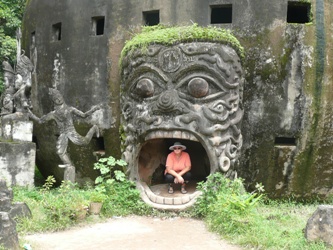
+ Click to enlarge
|
27 Jan 2010:
Leaving Langkawi we made our way north day sailing towards Phuket.
Twenty miles from Phuket having a lovely sail in 10 knots under asymmetrical spinnaker we had a huge roundup. After regaining control we saw that the end fitting had come away from the carbon prodder pole which resulted in a tear along the pole about one metre long. Also during the roundup our elephant on the mantle piece had taken out the Komodo dragon and the Chinese junk.
Much super glue needed there.
Unfortunately no amount of super glue would repair the prodder and we contemplated the trip to the Andaman’s without it.
A few phone calls later Mark from Latitude 8 Yachts arranged to meet us when we anchored in Ao Chalong. A quick look by him ascertained that the prodder was repairable and 48 hours later we had it back as good as new. We were now ready to begin our passage to the Andaman’s.
Photo:
Seventh Heaven under Asyo
|

+ Click to enlarge
|
01 Feb 2010:
The Amazing Andaman Islands
Lying approximately 400 miles north west of Phuket in the Bay of Bengal are the Andaman and Nicobar Islands which are part of the Union Territory of India. The Andaman Archipelago is an oceanic continuation of the Burmese Arakan Yoma Range in the north and of the Indonesian Archipelago in the south. It is made up of some five hundred islands and because of its isolation has a large variety of endemic flora and fauna with dense rain forests and stunning coral reefs and white sandy beaches which still remain virtually untouched.
Of the 300,000 people that live in the Andaman Islands, a small minority of about 1,000 are Andamanese. The rest are mainly divided between Hindi, Bengali, Tamil and Punjabi people from the mainland.
The Andamanese is a collective term to describe the peoples who are the aboriginal inhabitants of the Andaman Islands which includes the Great Andamanese, Jarawa, Onge, Shompen, Sentinelese and the extinct Jangil tribes.
The Andamanese were hostile and said to be cannibals and repelled intruders until 1858 when the British decided to occupy the Andamans and establish a penal settlement in Port Blair which was first and foremost a repository for political prisoners following the war of independence.
The Andaman Islands were later occupied by Japan during World War 11. After the end of the war they briefly returned to British control, before becoming part of the newly independent state of India in 1947.
The Nicobar Islands are situated south of the neighboring Andaman Islands archipelago and has a population of around 50000. Roughly 65% of these are indigenous peoples the Nicobarese and Shompen tribes and 35% have ethnic origins from the Indian mainland and Sri Lanka.
The Nicobar Islands are believed to have been inhabited for many thousands of years.
These islands are off limits to tourist including cruising yachts as a measure to preserve the indigenous culture and way of life.
On 26 December 2004 the coast of the Andaman and Nicobar Islands was devastated by a 10-15 m high tsunami following the Indian Ocean earthquake. At least 6000 people were believed to have been killed. Several islands were heavily damaged with reports of islands broken in two and coral reefs moved above water. Some estimates said that the islands were moved as much as 30 metres by the earthquake.
Photos:
South Rutland Island where the only foot prints were ours and the wounderful wildlife, turtles, sea eagles, deer, monitor lizards etc.....
Havelock Beach No7 - Magnificent forests that grow right to the waters edge.
|
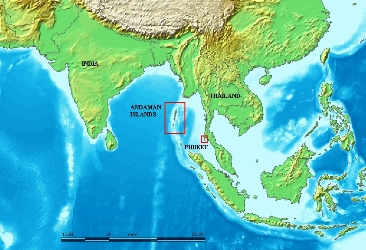
+ Click to enlarge
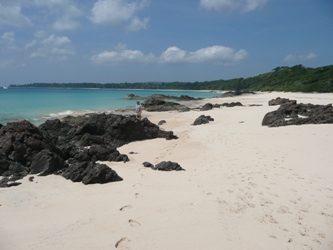
+ Click to enlarge
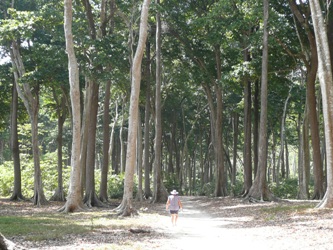
+ Click to enlarge
|
02 Feb 2010:
Our passage to the Andamans took three days and was uneventful. We enjoyed light northerly winds, clear skies and a full moon at night. We sighted a few ships midway and had dolphins join us on occasions. Caught a nice mackerel that supplied us with fish for six meals.
On arrival at Port Blair the capital and port of entry we had to wait to be boarded by customs, immigration, coast guard and then visit the harbour masters office. These formalities took three days requiring reams of paperwork and lots of patience fortunately immigration checked us in on the first day so we were free to go ashore in the evenings.
A contributing factor for the delay in being cleared was the ‘Milan 2010’ a naval friendship exercise. The visiting war ships from most Southeast Asian countries and Australia were arriving in port for the festivities and it made an impressive sight.
Photo:
Port Blair Harbour
|
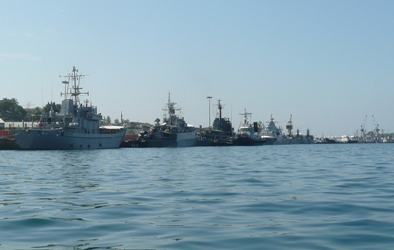
+ Click to enlarge
|
03 Feb 2010:
Port Blair was originally a harsh penal settlement established in 1858 by the British for Indian political prisoners who were uprising against British rule. Port Blair today is a busy port and the town is typical Indian friendly, dirty and crowded. We found it an exciting town with interesting shops, bazaars, stalls and markets, women dressed in colourful saris, the fragrant spices and lots of delicious samosas and curries. The sacred cows, goats, dogs, cats, chooks, ducks and rats were everywhere mucking about in the garbage and laundry was hanging out to dry by the road side. The government cars, motor bikes, taxis and heavy transport vehicles were mostly straight out of the 1950’s.
Our taxi driver, Ravi who is a yachties icon in Port Blair became our guide and friend and made life very easy during our visit, organising fuel, sim cards, trips to the markets, shops, and restaurants as well as the usual tourist sights including the Cellular Goal, Anthropological Museum and Ross Island.
While visiting these tourist sights a thing we found very peculiar was Indian tourists from the mainland wanted to have their photo taken with us for their holiday memories. Weird but nice.
The Cellular Goal built in 1910 had seven wings radiating from a central tower containing 698 cells designed for solitary confinement and was a reminder of how inhuman the British were in past times. While the exact number of prisoners who died in this prison is not fully known, it is estimated they number in the thousands.
Ross Island guards the mouth of Port Blair harbour and was the British settlement and headquarters with grand Victorian buildings and was known as the ‘Paris of the East’. In 1941 a large earthquake damaged many of the buildings and soon after the Japanese occupied the island. The British never returned and today the old buildings are in ruins and jungle clad and it is like exploring a lost city.
Photos:
Our favorite samosa restaurant.
Main Street Port Blair – Aberdeen Bazaar
Making chapati – Indian favorite with dhal
|
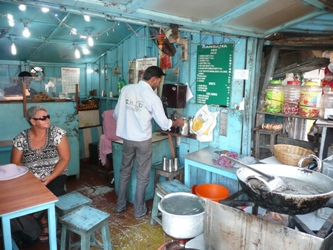
+ Click to enlarge
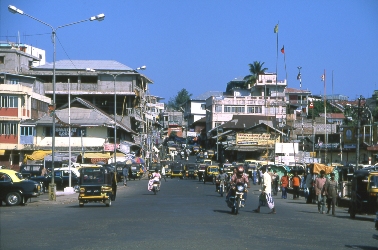
+ Click to enlarge
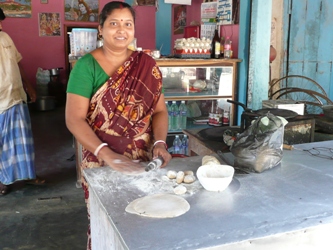
+ Click to enlarge
|
05 Feb 2010:
After all the paper work was done we left Port Blair for the uninhabited islands for which the Andaman's are noted.
Our first night was at South Cinque Island 30 miles south of Port Blair. We anchored off a pristine white beach and ashore we could see spotted deer amongst the trees. As the sun began to set a pod of dolphins swam around us. This was defiantly paradise.
At North Cinque Island we went snorkeling and though the coral was ordinary the clarity of the water more than made up for it.
The anchorage at South Rutland Island was again off a pristine beach and we could see fresh turtle tracks above the high water mark. In the late afternoon the beach came to life; spotted deer along the tree line with birds chirping above, monitor lizards and sea eagles competing for the turtle eggs and sea birds wading in the shallows.
Chiryatapu is a small bay on the southern end South Andaman Island with a picnic area popular with the locals at the head of the bay. There were turtles popping their heads up around us and though the sign on the beach advised that ‘crocodiles infest these waters’ the reef in a small bay to the east had the best diversity of coral and fish that we experienced during our visit to the Andamans. Remind you I spent a fair bit of time glancing behind us as we were snorkeling.
Photos:
South Cinque Island
Spotted Deer
|

+ Click to enlarge
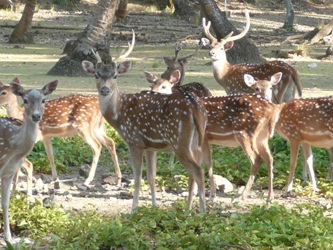
+ Click to enlarge
|
12 Feb 2010:
Twenty five miles north of Port Blair is Havelock Island the main tourist island with lots of beach huts and backpacker accommodation and is reached by ferry from Port Blair. The anchorage at Beach No7 was in clear water and had a three mile long white sandy beach with coral reefs at each end backed by a tropical forest. Ashore there were cheap eateries and a bus service that went around the island and to the main village where supplies could be obtained.
We celebrated Betty’s and Pete’s birthday on ‘Wave Runner’ with Kathy and Gerry and Donna off ‘Scott Free II’.
As the sun sets over the Andamans and the retired logging elephants are bought down to the beach for a late afternoon swim you could easily see yourself remaining here for weeks but there was much more to explore.
Neill Island was like going back to the 70’s the backpackers here were so layback and dressed much like the hippies of our era.
The anchorage at the southern end of Henry Lawrence was simply beautiful it had a small beach and was surrounded by a coral reef. Only inhabitant was a lonely brown dog on the beach that serenaded us at sunset.
We visited Inglis and Outram Islands where I caught a nice Spangled Emperor for dinner.
At North Button Island we anchored in 25m and could see the bottom. The snorkeling here was sensational with lots of large fish including a school of about 30 giant Mouri Wrasse.
Photos:
Afternoon swim at Havelock Island.
Sunset at Havelock Beach No7
|

+ Click to enlarge
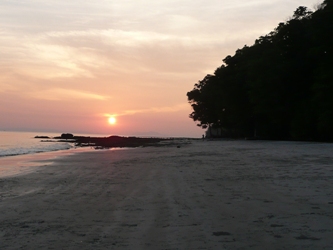
+ Click to enlarge
|
23 Feb 2010:
Long Island is situated just off the southeast end of Middle Andaman and has a small village on the southwest end.
We joined ‘Scott Free II’ for dinner at the Blue Planet a backpackers hostel where we had chicken curry without the chicken and Gerry’s special onion salad six slices of onion with pepper sprinkled on top.
Next day we caught the local ferry up the mangrove lined waterways to Rangat the largest town on Middle Andaman. The bus from the jetty was packed and took 30 minutes over bumpy roads making it hard to keep our footing.
Rangat was a dusty, dirty town but with character. Very few foreigners visit Rangat and we had some interesting experiences. We went to the bank to change some money and were served ahead of the long queue with the security guard watching over us with a WWI rifle over his shoulder. Betty needed to use a toilet so we went to the post office to ask where the public loo was located quickly she was whisked away out the back to their private air conditioned lavatory we later saw the public loo and I think she was a very lucky lady. We tried to buy some green bananas but were refused the shop keeper insisting they were no good and when Betty went to buy a newspaper she was informed they were for reading and not for sale but not free either.
Photo:
The local ferry.
Rangat's main street.
|
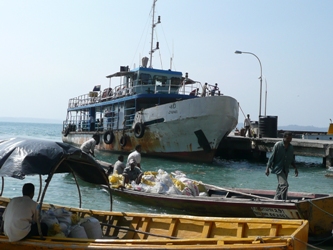
+ Click to enlarge
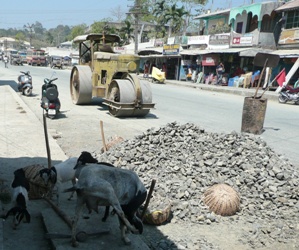
+ Click to enlarge
|
02 Mar 2010:
Our month in the Andamans had come to an end and we sailed back to Port Blair to check out. On arrival we were informed that Monday was a public holiday to celebrate Holi and we could not check out until Tuesday the last day on our visa.
Holi is a Hindu festival to celebrate the beginning of spring. During the festival coloured water and powder (gulal) is thrown over each other in a carnival like atmosphere.
We decided to spend the day touring the southern end of the island visiting a fauna and flora research centre, Wandoor beach and rubber and spice plantations. We stopped at the town of Sippighat for lunch where we joined the locals in their celebration. Lots of fun and laughter was had by all.
Next day Ravi took us to visit the Harbour Master, Customs and Immigration to check out and the whole process only took 3 hours compared to our 3 days for entry.
Our return trip to Phuket started in 15 knots of wind and we were cruising along at seven knots. Twelve hours later the wind dropped and we had to motor sail for sixty hours, all the way to Phuket. I suppose that is better than 20 knots on the nose.
Our month in the Andamans swimming and snorkeling in crystal clear water with an abundance of coral and fish, eating freshly caught seafood, sight seeing and exploring mostly by ourselves had been incredible and was well worth the effort to get there.
Photos:
Happy Holi
Our driver Ravi 2
Betty and Ravi
|
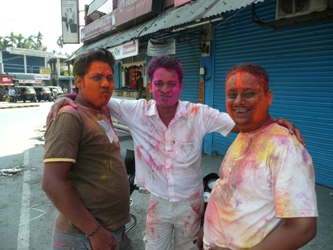
+ Click to enlarge
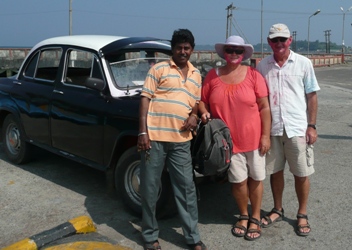
+ Click to enlarge
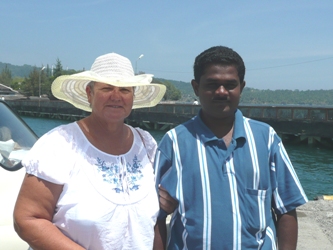
+ Click to enlarge
|
20 Mar 2010:
Kevin and Heather join us in Phuket
It is always good politics to keep a close relationship with the commodore of your local yacht club so the invite went out to Kevin and Heather to join us on Seventh Heaven to sample the sights and tastes of Phuket.
The first three nights they spent ashore at the Light House Hotel in Ao Chalong during which time we toured Phuket Island by car, provisioned and introduced them to the local cuisine and beer.
Time to go sailing and as usual the wind had come up during the night causing a nasty little onshore chop. I loaded Kevin and Heather with their gear into the dinghy and headed off needless to say by the time we reached Seventh Heaven all parties were soaked and gear bags were floating in the dinghy (didn’t want to spoil them on their first day).
We spent the next nine days exploring the islands and tourist destinations of Phang Nga Bay under clear skies.
We celebrated Heather’s birthday at the Le Grand Blue on Phi Phi Don one of our favorite restaurants but maybe not Heather’s as she was unwell the next day. We visited the tourist destinations of Rai Lei Beach and Ao Nang where some serious souvenir shopping took place and explored the Diamond limestone caves.
The highlight for Kevin and Heather was the stilted Muslim fishing village on Koh Pan Yi with all its souvenir stalls and seafood restaurants.
Photos:
Heather’s birthday at Phi Phi Don
On the beach at Koh Racha Yai
|
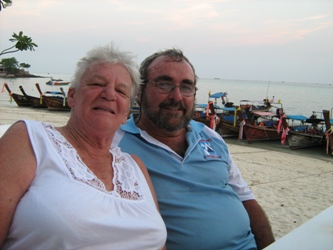
+ Click to enlarge

+ Click to enlarge
|
25 Dec 2010:
Home for Christmas
The rain came down but it didn’t dampen our delight to be spending Christmas with our family.
It had only been three months since our last visit home but how Mia (22 months) and William (5 months) had grown.
We had a fabulous day playing Santa, devouring a sensational home made seafood smorgasbord followed by heaps of fun in the pool.
Photos:
Emma and Kathryn enjoying lunch
Mia totally wrapped
Spa time for William
|
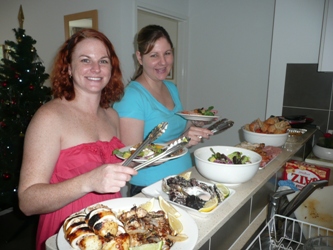
+ Click to enlarge
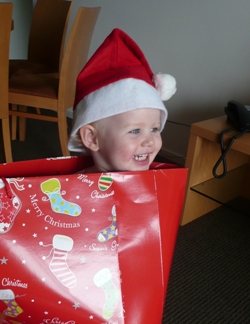
+ Click to enlarge
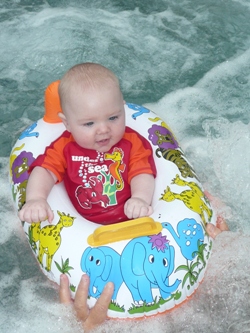
+ Click to enlarge
|
02 Jan 2011:
The festivities all over we took the opportunity to visit a few old cruising friends and take a short visit to Airlie where we caught up with Bob and Kath Borer (Janner II) they have just returned from visiting family in the USA and two months in Italy.
We had a wonderful afternoon with Stewart and Nanette (Truest Passion) it was great to see Stewart looking so well and that the chemo has slowed the spread of his cancer. They have a beautiful retirement unit on the Mooloolaba canals with all the amenities and activities that you would expect in a five star resort. If Stewart’s health keeps improving they are going to sail up to Lizard Island later this year.
Also had dinner with Richard and Gloria (Aquarius I) they are now back in their unit at Margate north of Brisbane and Aquarius I is on the market. Their plan is to purchase a canal boat in France and cruise the canals of Europe for a few years. Hope they have room for all their friends.
Photo:
Lunch with Stewart and Nanette.
|

+ Click to enlarge
|
12 Jan 2011:
Queensland Floods
The rain over Queensland was relentless and with all the dams full from heavy rains in November there was no way to stop the flow of water down through the river systems.
The devastation was on a scale not before seen and bought the state to a standstill and affected every Queenslander either directly or indirectly.
Tragically lives were lost and homes, businesses and crop destroyed. It will take a long time for recovery. Tourism a major industry in Queensland was already going through a difficult period due to the strong Australian dollar enticing people to take holidays overseas.
Fortunately we were unaffected by the floods except for the cancellation of the train to the Gold Coast from Brisbane on our return from Airlie Beach.
Emma our youngest daughter who lives in Toowong an inner city suburb of Brisbane had to evacuate her unit and the power was cut off but thankfully the water only came up to the end of her street.
Photos:
Flooded homes in Brisbane
The big cleanup
|
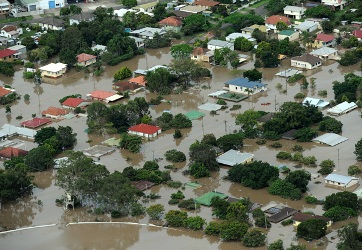
+ Click to enlarge
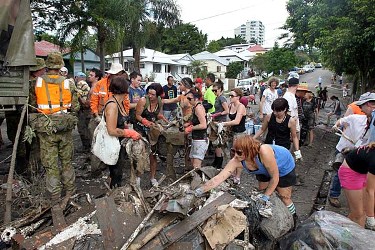
+ Click to enlarge
|
03 Feb 2011:
Cyclone Yasi
Just when you think Queensland has had all it can take from Mother Nature along comes cyclone Yasi the largest and most powerful cyclone in living memory to hit the Queensland coast.
Although communities in the cyclones path had plenty of warning to prepare when it crossed the coast south of Cairns it left a trail of destruction behind with houses and businesses destroyed or badly damaged and Port Hinchinbrook marina in Cardwell literally turned upside down miraculously no lives were lost.
Thankfully the Whitsundays and Airlie Beach our home town only had minor damage to some properties.
Photos:
Satellite image of cyclone Yasi crossing the coast.
Port Hinchinbrook marina destruction
|

+ Click to enlarge
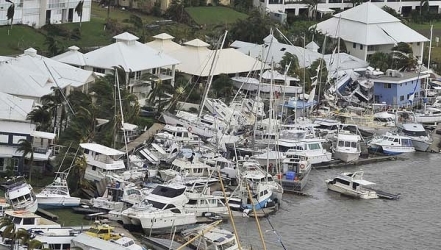
+ Click to enlarge
|
26 Mar 2012:
On The Hard
The plan a quick haul out to antifoul then spend a month cruising the west coast of Thailand.
Why would we think this was not possible?
Five weeks later we are finally back in the water with a full osmosis protection barrier applied, boat polished, new main sail drop bag, new cockpit cushions, anchor chain re galvanised, forward storage locker modified etc...
Fortunately Phuket Boat Lagoon marina has excellent maintenance facilities and also incorporates a resort hotel so no need to stay on the boat while the work is being carried out. A fully serviced studio apartment cost only 10500 baht per month ($330)
The good news is that Seventh Heaven is now in A1 condition for the two year passage back to Australia.
|

+ Click to enlarge
|
27 Mar 2012:
Our plans of circumnavigation have been put on hold. The Somalia piracy problem in the Indian Ocean has escalated to point where it has become too dangerous for us to contemplate going any further west.
Many yachts are taking the South African route or are shipping from Thailand to Turkey by container vessels. Neither of these options is acceptable for us. The Mediterranean Sea via South Africa is too far and would take two years plus and two Atlantic crossings. Shipping Seventh Heaven to the Med will cost $1000 per foot-that means $41,000, money, we do not have. Also $41,000 equates to a lot of charters or land travel we can do some other time.
After three glorious years sailing the waters of West Malaysia, Thailand and The Andaman Islands we are headed east this year joining the Sail Malaysia - Passage to the East Rally to Borneo.
|

+ Click to enlarge
|
25 Dec 2012:
Christmas time in Australia.
It is this special time of the year that we lock up Seventh Heaven and travel back to Australia to be with family and friends.
We celebrated Christmas Day with lunch at Pepper Resort with our friends Terry and Anita.
Ken, Kathryn, Mia and William arrived that evening staying for a week in Airlie so Betty and I got plenty of time with the grand kids.
Photos:
Charlie & Betty
Fun time in the pool
|

+ Click to enlarge
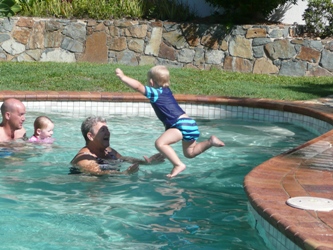
+ Click to enlarge
|
27 Jan 2013:
Slow Travel
As we make our way towards the Philippines the NE winds keep coming.
We left Miri in nice calm conditions but all was to change dramatically as we rounded Batang Baram some two hours out. We found ourselves punching into a two meter sea and twenty knot head wind not what you really need on your first day out. We arrived in the safety of Jerudong Harbour well after dark tired and hungry. Next morning conditions had improved so we made for Labuan to stock up on essential duty free supplies (beer, wine and rum).
After three days holed up in busy Victoria Harbour with water taxis buzzing all around and dueling Mosques we finally braved the conditions and headed for Tiga Island.
The anchorage was calm and quite. Tiga Island is a national park and was the site of the first survivor television series.
The island is covered with rainforest with many maintained walking tracks and an abundance of wild life. In the centre of the island there are volcanic mud pools where if you wish you can take a mud bath Betty was not to keen on this.
We stayed here for two nights enjoying the serenity.
Photos:
Tiga Island
Mud pools
|
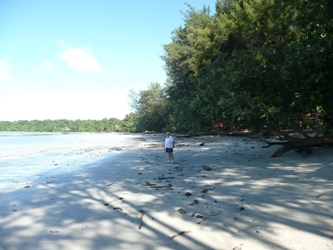
+ Click to enlarge
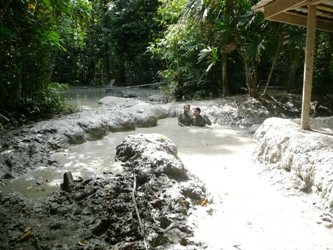
+ Click to enlarge
|
06 Feb 2013:
With the wind more from the north we managed to sail for a few hours on the way to Kota Kinabalu.
Sutera Harbour Resort Marina in Kota Kinabalu is the most luxurious marina in Malaysia and is connected to a five star resort. We were allowed full access to the resort amenities including pools, gym, Wifi etc. and this was all included in our $25 per day berthing fee.
Our water maker had given up and we required a new membrane 10 days and $1200 later we were again operational.
Photo:
Sutura Harbour
|
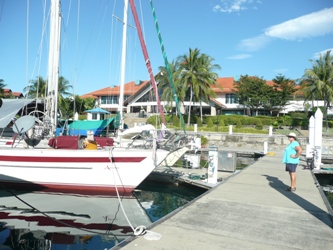
+ Click to enlarge
|
17 Feb 2013:
The sea conditions had improved so time to go. Spent the first night anchored in Ambong Bay 30 miles north of Kota Kinabalu with majestic Mt Kinabalu in the distance. At first light we motored towards the Tip of Borneo where again condition deteriorated and it was hard going to round the cape once around we had a nice reach down to Kudat.
Kudat Marina and Golf Resort have a small harbour and marina surrounded by the golf course. The marina has no power or water though you can use all the facilities at the resort which is only a few minutes walk and it is free.
Though the Philippines are only 50 miles away the wind and sea conditions have been adverse so we have settled in here spending time with new and old friends while we wait for our weather window.
Photos:
Mt Kinabalu at dawn
Kudat marina
|
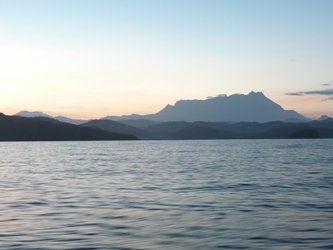
+ Click to enlarge
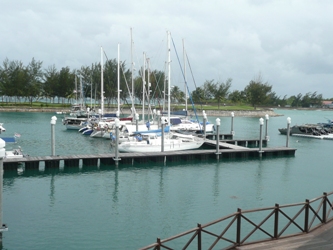
+ Click to enlarge
|
21 Feb 2013:
The Philippines
After two weeks hold up in Kudat waiting for a small cyclone to pass over Palawan (hopefully the last for the season) we finally had a favorable forecast to make our passage across the Balabac Strait.
We departed Kudat in a light norwesterly navigating through the passage between Balambangan and Banggi Islands as we exited the passage we were confronted with a one meter swell and torrential rain which lasted for over an hour (tail end of cyclone). With twenty miles to travel the wind increased to 20/25 knots making the seas stand up and very confused giving us a fast but very rough last few hours. We anchored in Clarendon Bay at the southern end of Balabac Island although it had a slight roll it was well protected. There were small huts scattered around the bay and a few locals came out to trade bananas.
The wind had eased overnight but the forecast was 15/20 knot noreasterlies for the next four days (on the nose) so we decided to do a sixty mile day and head for Tuba River. We motor sailed through the small islands and reefs between Palawan and Bugsuik Island protected from the swell. Fortunately we had been given tracks of other yachts and finding the entrance to the river was very easy we anchored upstream from the village and settled in to sit out the adverse weather.
Photos:
Tuba River
Bangka's (Spider Boats)
|
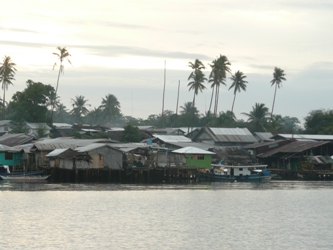
+ Click to enlarge
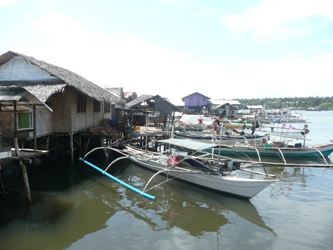
+ Click to enlarge
|
27 Feb 2013:
Our time in the Tuba River was spent relaxing with the occasional excursion ashore. The village was compact and dusty party due to the nickel ore being loaded onto barges at the mouth of the river.
Though off the beaten track and referred to as ‘the home to smugglers and modern day pirates’ by travel guides we found the locals friendly if not a bit shy and inquisitive.
There were plenty of small shops selling an assortment of goods including phone and internet cards and the small market had plenty of fresh fruit and vegetables.
We caught a tricycle into the town of Rio Tuba which is about 3 klm away which consists of small dirty and dusty shops along both sides of the main road for about ½ klm. To our surprise there was a franchised BBQ chicken outlet which looked way out of place which we now know are found all through the Philippines.
Photos:
Tuba River Village
Tircycle
Dinghy Dock
|
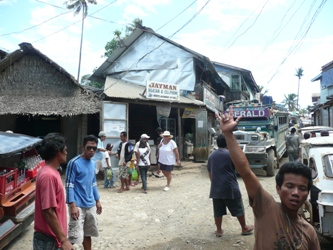
+ Click to enlarge

+ Click to enlarge
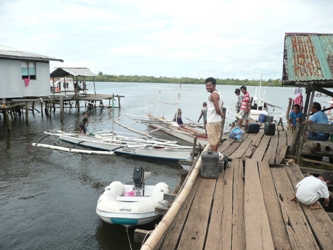
+ Click to enlarge
|
01 Mar 2013:
The passage from Tuba River to Puerto Princesa was 130 miles which we completed over three days.
Leaving Tuba River the wind was light but within an hour had picked up to 15/20 knots with lumpy seas. Despite this we decided to push onto Brookes Point. A long day motoring into a headwind averaging just over four knots.
Brookes Point has a small port that services the south east coast of Palawan. We anchored off the jetty protected by a small sea wall. There was a village ashore but we had no visitors.
Better conditions greeted us next morning and we headed for Rasa Island passing many fishing Bangka’s along the way. The anchorage on the western side of Rasa Island was very peaceful and uninhabited.
Light conditions prevailed for the final leg to Puerto Princesa.
Photo:
Fishing Bangka
|

+ Click to enlarge
|
09 Mar 2013:
Puerto Princesa is the capital of Palawan with a population of 200000 predominately Christian (catholic) and very clean compared to other SE Asian countries. As a tourist destination Puerto Princesa has not much to offer it is more the stepping off point for other parts of Palawan.
Puerto Princesa Bay is a large deep natural harbour accommodating large cargo ships, cruise liners, naval base and many water villages.
We anchored off the Abonica Yacht Club two miles past the town. The club is basic and very laidback run by John and Cissy who go out of their way to make your stay enjoyable. The club has all the usual facilities bar, restaurant, library, WiFi, showers etc. Every Sunday Cissy does a splendid buffet lunch or dinner and sundowners are partaken each afternoon around 5.30 very easy to get trapped here and not sail on.
The major mode of transport is the tricycle (motor bike with sidecar) and there are literally thousands of them. There seems to be no limit on the number of passengers or goods as long it can fit in or on. A ride into town from the yacht club which takes about 15 minutes cost 50 pesos ($1.25) for two people.
Shopping comes in various forms from modern western style shopping malls to traditional produce and wet markets (meat and seafood) with everything except fuel being very cheap.
There are also a large variety of food outlets the national dish being ‘Adobo’ (meat or seafood stewed in vinegar and garlic) unfortunately it is not quite up there with Thai and Malay cuisine though they do bake better bread. For those who enjoy a drink wine is around $5 a bottle rum $4 and beer $12 a carton.
The one notable difference when shopping in Puerto Princesa is all the larger stores, banks and restaurants etc have armed guards even the traffic enforcer at the shopping mall was armed.
Photos:
Abonico Yacht Club
Singing traffic enforcer
Tricycle
|
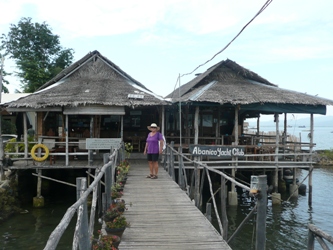
+ Click to enlarge
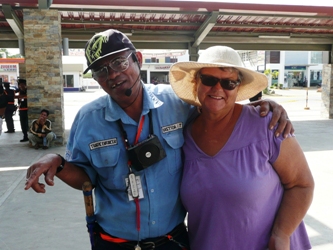
+ Click to enlarge
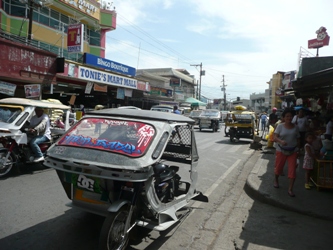
+ Click to enlarge
|
14 Mar 2013:
Puerto Princesa to El Nido
The weather forecast for the next five days was for NE winds 5/10 knots so finally raising the anchor and made for El Nido in company with ‘Two Up’ and ‘Wings & Strings’.
Day 1. Distance 22nm
In calm conditions we motored out of Puerto Princesa Bay and north to Snake Island in Honda Bay. This was a small uninhabited island with a sand spit that went to the north for miles. We anchored in the lea of the spit in 20m of clear water after which we gave the hull a scrub and went off exploring the spit.
Day 2. Distance 50nm
Flat seas and clear skies ideal for another day of motoring to our destination Reef Island in Green Island Bay.
During the afternoon we sailed through a large pod of spinner dolphins that put on a display of aerial acrobatics spinning many times as they leapt out of the water.
Reef Island is small with a reef extending to the south east and has a low key resort. We had a nice snorkel along the reef (first in the Philippines) and walk around the island.
Day 3. Distance 55nm
Again calm conditions prevailed as we motored though the reefs and shoals of Green Island Bay to the Dumaran Passage. The passage is a navigators nightmare though the charts are accurate the passage is littered with pearl farms for about ten miles.
After exiting the passage our course was more north and we were able to sail for the last ten miles to Acadambanauan Island. We anchored in a well protected deep bay (24m) dotted with fishing villages.
Day 4. Distance 37nm
With the wind from the NE at ten knots and our course north we were able to sail all day to Darocotan Island. The anchorage was tricky to approach and had a bit of a roll but it was an attractive island with a neat and tidy fishing village and backpacker facility for overnight stops. Bangka’s do five day budget cruisers from El Nido to Coron and vice versa stopping off at islands for the night on the way.
Day 5. Distance 29nm
The weather remained light and we motored around the tip of Palawan and down to El Nido greeted by spectacular scenery of limestone islands. The anchorage at El Nido was a bit rolly so we went around the head land to Corongcorong the protected anchorage on the southern side.
Photos:
Reef Island
Seventh Heaven under sail
Anchorage at Corongcorong
|
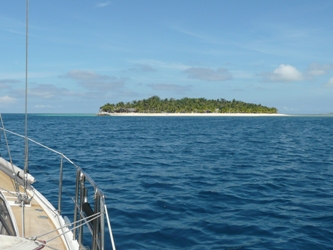
+ Click to enlarge
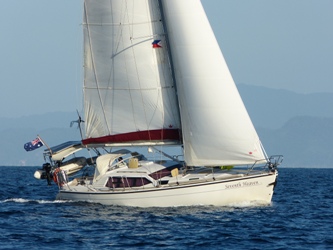
+ Click to enlarge
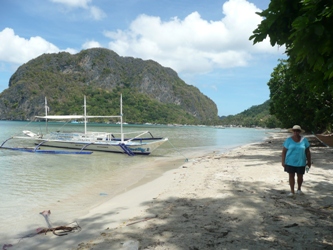
+ Click to enlarge
|
15 Mar 2013:
Something I forgot to mention the sky is very clear in Palawan and the sunsets are stunning as are the stars at night.
Photo:
Sunset in Palawan
|

+ Click to enlarge
|
06 Jul 2013:
10th Borneo International Yacht Challenge
Time to race.
The race from Miri to Labuan is always interesting we started with a lovely reach at 7 knots for the first four hours then as the wind lightened we were ghosting though the Brunei oilfields. Midnight thunder storms all around us tacking backwards and forwards early hours of the morning nice land breeze reaching to the finish line. At dawn with the finish line only eight miles away becalmed such is yacht racing.
The Labuan bay races were held in light conditions and Seventh Heaven and the crew performed well gaining a 2nd and 3rd place.
Labuan is a duty free port and our last chance to stock up on vital supplies such as beer, wine, rum and gin for the passage back to Australia so we were a little lower in the water for the race to Kota Kinabalu.
The race to Kota Kinabalu was a mixture wind, storms, no wind though we managed to keep Seventh Heaven moving and picked up another 3rd place.
The bay races in Kota Kinabalu were cancelled due to lack of wind.
We had a great time racing our home and were a respectable 3rd overall.
Photos:
The windward mark ahead of Bewitched though not for long
Seventh Heaven’s pretty sail
Dinner Labuan to KK in light conditions
|
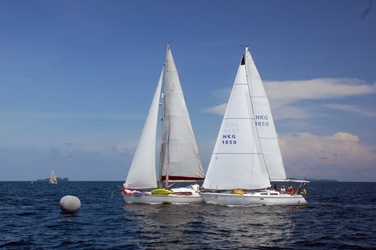
+ Click to enlarge
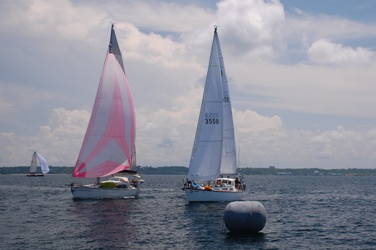
+ Click to enlarge
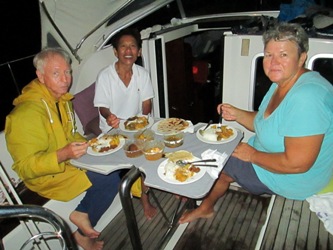
+ Click to enlarge
|
07 Jul 2013:
10th Borneo International Yacht Challenge
In SE Asia they have fantastic regattas and the BIYC is no exception.
The regattas are truly gala events with fantastic dinners and presentations by dignitaries and VIP’s all being followed by the mass media. Even the humble cruising yachts are treated like super stars.
The regatta starts in Miri (Sarawak) to Labuan then onto Kota Kinabalu (Sabah). There are six races two passage races Miri to Labuan (105nm) and Labuan to Kota Kinabalu (70nm) with two bay races in both Labuan and Kota Kinabalu. Seventh Heaven was entered in cruising division A and this year we had the luxury of crew our new friends Ray and Patsy from Miri.
Photos:
Winners are grinners
Still friends (Ross off Bewitched overall winner cruising A)
Welcome dinner Miri (Ray, Patsy and Kevin)
|
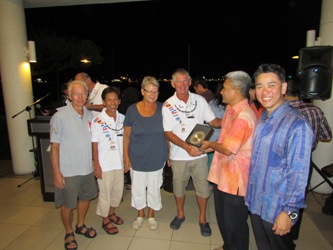
+ Click to enlarge
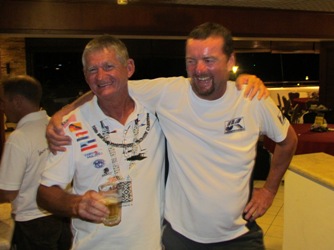
+ Click to enlarge

+ Click to enlarge
|
|
|
|
 The
Cruising Adventures of Seventh Heaven with Charlie and Betty
The
Cruising Adventures of Seventh Heaven with Charlie and Betty The
Cruising Adventures of Seventh Heaven with Charlie and Betty
The
Cruising Adventures of Seventh Heaven with Charlie and Betty